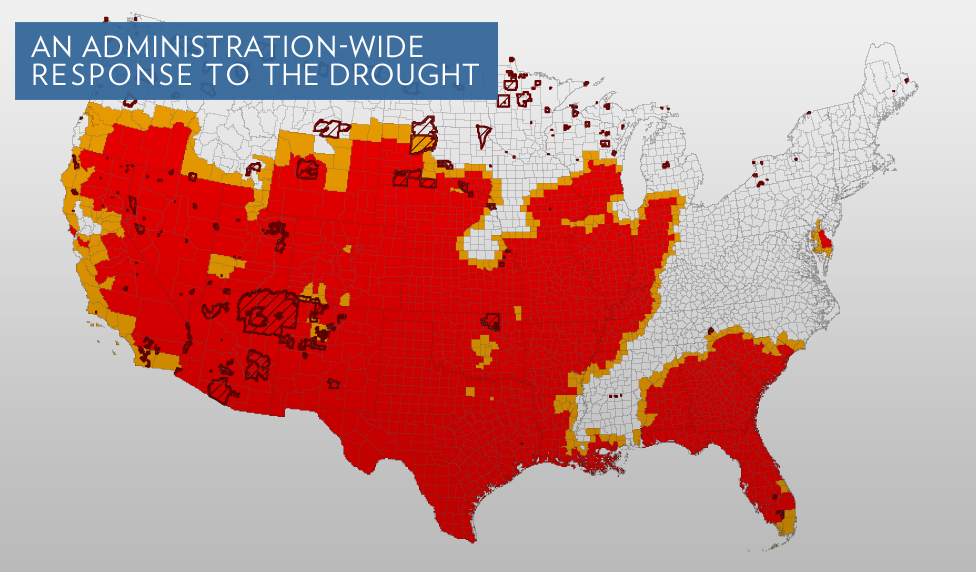
Drought
Throughout much of the country, communities are struggling with one of the worst droughts to strike the U.S. in decades. The lack of rain and high temperatures have done considerable damage to crops -- particularly those in the Midwest.
To meet the challenge, The U.S. Department of Agriculture is coordinating the response to help farmers, ranchers, and small businesses wrestling with this crisis.
Help for Farmers and Ranchers
The USDA is providing millions of dollars in assistance to restore livestock lands affected by the drought. The department will spend $16 million on technical and financial assistance for those whose crops or herds have suffered, and will buy $170 million worth of pork, chicken, lamb, and catfish to aid livestock producers.
Secretary of Agriculture Tom Vilsack has also announced the USDA will file special provisions with the federal crop insurance program to allow farmers to plant a cover crop without risking crop insurance coverage in 2013, providing much needed forage and feed this fall and winter.
The USDA has also reduced interest rates on its emergency loan program, worked with the major crop insurers to allow farmers to fore go interest payments on unpaid premiums until November, and issued grants to evaluate agricultural practices that help farmers and ranchers adapt to drought.
The Department of the Interior has announced a plan to provide more relief and flexibility to ranchers whose livestock grazes on public lands.
Additional Resources
Find your local Farm Service Agency (FSA): Map
Information about Emergency Disaster Designation: Factsheet
Disaster Designated Counties: Map, List of Counties
Help for Small Businesses
The National Credit Union Administration also announced that more than 1,000 credit unions are increasing their lending to small businesses (including farmers). The Army Corps of Engineers is working to ensure that the drought doesn't impede navigation of the nation's rivers, and the Department of the Transportation is working with state governments to provide emergency waivers of federal truck weight regulations and hours of service requirements to drought-stricken communities.
Drought recovery loans are available through the U.S. Small Business Administration. Eligible businesses include:
- Small, non-farm businesses
- Small, agricultural cooperatives
- Small businesses engaged in aquaculture
- Most private, non-profit organizations of any size
Eligible businesses can apply for Economic Injury Disaster Loans (EIDLs) of up to $2 million to help meet financial obligations and operating expenses which could have been met had the disaster not occurred. These are working capital loans and can be used to cover operating expenses – like utilities, rent, and monthly overhead that would have been paid if the disaster had not occurred. The interest rate is 4 percent for businesses, 3 percent for nonprofits, with terms up to 30 years. You can view detailed eligibility requirements and apply online.
Science and Climate Change
Many types of extreme weather events, such as heat waves and regional droughts, have become more frequent and intense over the past 40 to 50 years. As climate change continues, droughts are expected to become more frequent and severe over much of the United States. The U.S. Department of Agriculture (USDA), the National Oceanic and Atmospheric Administration (NOAA), the Department of Interior (DOI), the Department of Energy (DOE), and other Federal partners are studying the science of drought to understand these trends, their impacts, and their connections to climate change.
For More Information
Read the full fact sheet outlining more details of the Obama administration response here.
The USDA has been aggregating resources for those affected by the drought here.
The National Weather Service has detailed drought information, including a seasonal outlook, here.
The U.S. Geological Survey publishes maps, graphs, and tables describing real-time, recent, and past water conditions for the United States at WaterWatch.

President Barack Obama meets with the White House Rural Council to discuss ongoing efforts in response to the drought, in the Roosevelt Room of the White House, Aug. 7, 2012. Among those attending with the President were, from left, Labor Secretary Hilda L. Solis, Agriculture Secretary Tom Vilsack and Karen Mills, Administrator of the Small Business Administration. (Official White House Photo by Pete Souza)
Related Blog Posts
- August 13, 2012 at 7:08 PM EDT
More Help for Those Coping with the Drought
In Iowa, President Obama describes a new effort to help livestock producers coping with one of the worst droughts in a half century.
- August 11, 2012 at 5:30 AM EDT
Weekly Address All-Hands-On-Deck Response to the Drought
President Obama discusses the Administration’s all-hands-on-deck approach to one of the worst droughts in more than fifty years.
- August 8, 2012 at 12:01 PM EDT
Assistance for Small Businesses Affected by the Drought
A guide to the tools and the resources hard hit communities need to navigate and recover from these severe drought conditions
- August 7, 2012 at 5:19 PM EDT
An Administration-Wide Response to the Drought
President Obama meets with White House Rural Council to discuss the steps being taken to help farmers, ranchers, and small businesses wrestling with the historic drought.







